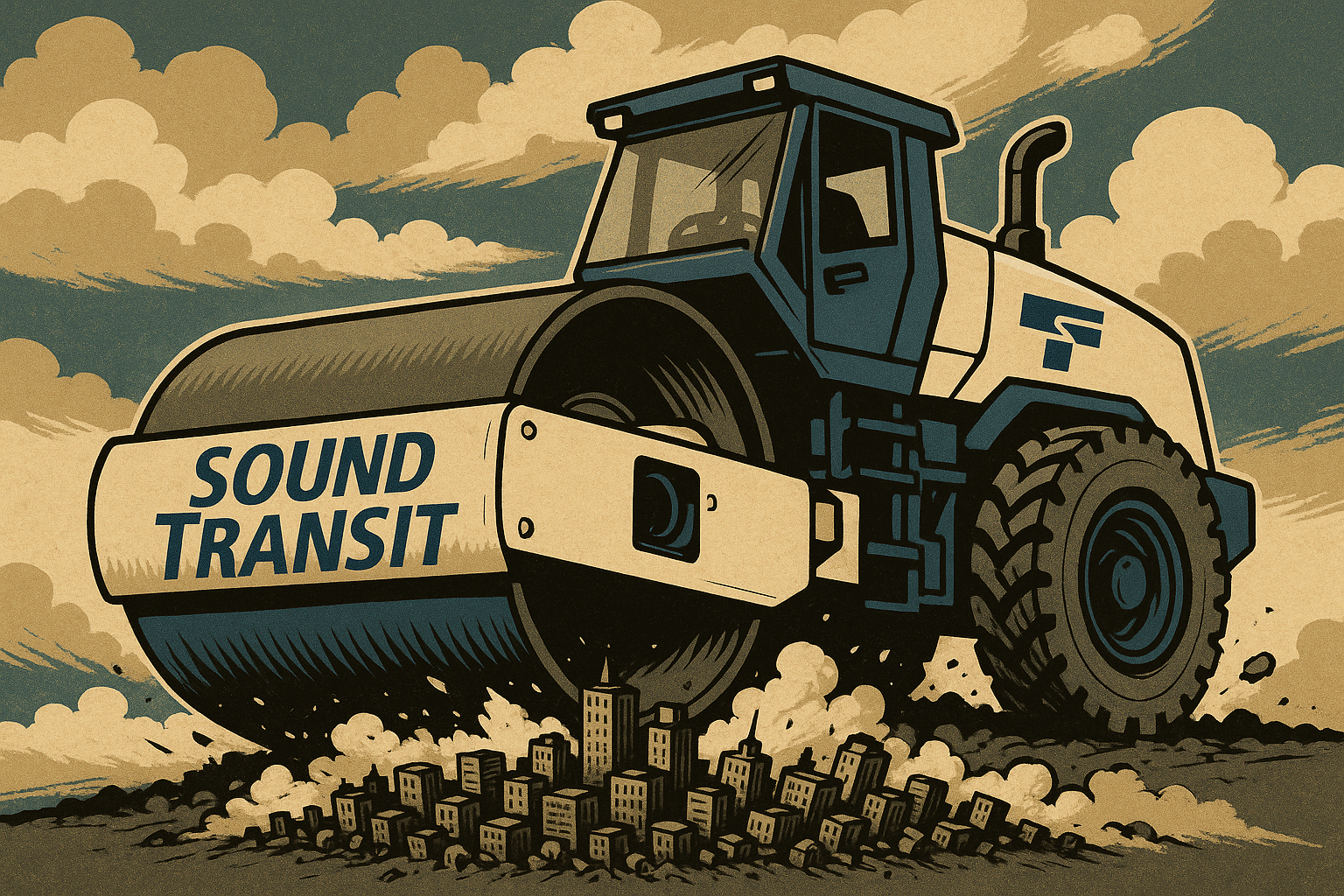Related Articles
OFM’s letter raises valid questions about the legislature’s highway budget proposals but fails to identify underlying causes or offer effective solutions
The State Office of Financial Management (OFM), which reports to Governor Inslee, has sent a sharply worded letter to the chairmen and ranking members of the Legislature’s Transportation Committees expressing “significant concerns with the House and Senate transportation budgets” now under consideration.
It is surprising that OFM would weigh-in so critically and so late in the legislative session considering the House and Senate transportation budgets are largely in alignment as to size and major line items. Even most of the minor line items appear easily reconcilable. The major difference is in how they propose to cover the cost. The Senate proposes to raise $1.4 billion in the 2013-2025 biennium through the sale of bonds, which may not be prudent given existing debt load, revenue uncertainty, and rising interest rates.
The House balances its budget proposal by assuming WSDOT delays over one billion dollars of construction and highway preservation projects. That underspending would allow the legislature to assume the unspent funds will be available for other stuff. The bottom line is that neither the House nor Senate budget assumptions are good public policy.
The OFM letter raises a number of valid questions, but it completely overlooks how many of the budget problems can be traced back to policies enacted at the Governor’s request and by the Governor’s own Executive Orders. The problems the Legislature is wrestling with didn’t suddenly pop-up out of nowhere, many of the issues have been apparent for a decade, which raises the question of why so little progress has been made despite large increases in state revenues from taxes and fees.
A few observations:
- The OFM letter points out that highway preservation and maintenance are underfunded. This is true, but it’s not a recent discovery. State transportation budgets have been focused on other policy goals for many years. The letter also mentions that the Legislature substantially increased preservation and maintenance funding in 2022, but they don’t say much about why WSDOT was unable to complete many of the funded projects. This was partly due to the lingering effects from the Governor’s draconian response to COVID, which caused staff to leave (some willingly, others not) and WSDOT’s ongoing difficulty in filling vacancies. The Governor should take the steps needed for dismissed WSDOT employees to return to work.
- The letter touches on underfunding for WSF’s hybrid-electric ferries. In the wake of WSF’s failure to reach agreement with Vigor Industries on construction of the ferries the Legislature is poised to pass HB 1846. That bill would enable a more competitive procurement process and encourage proposers to submit a more economical ferry design. The bids won’t be opened until late this year so it isn’t known to what extent the hybrid-electric ferry program is underfunded (as it may well be), but the letter makes no mention of the Governor’s Executive Order that led WSF on this prolonged and costly quest for a zero-carbon emission fleet. Had WSF simply ordered additional conventionally powered ferries under the existing (now lapsed) contract at least one new ferry would already be in service. Now it seems the blame is being shifted to the legislature for trying to address the problem and lower costs by moving WSF to a more competitive and expedited procurement process.
- OFM takes issue with the ambitious list of highway projects and complains the projects haven’t been prioritized and may not all be deliverable on schedule. That is a curious criticism since State law directs WSDOT to prepare a State Highway System Plan that “identifies program and financing needs and recommends specific and financially realistic improvements…”, but WSDOT hasn’t updated that plan since 2007. That plan used to be the starting point for the Legislature’s transportation budget, but with nothing current to go on development of the transportation budget has become a back-room exercise in sausage-making in which nobody is even sure what the recipe is. If OFM is taking the position WSDOT can’t deliver the funded projects, then the question the Executive Branch should answer is what is needed to get the job done. I also wonder why OFM’s skepticism doesn’t extend to the many costly non-highway projects in the budget. The House and Senate budgets propose doling out hundreds of millions of dollars to cities, counties, and transit agencies. It’s not like all of the intended recipients of those funds have a good track record of staying on time and within budget for their projects. Was there a transparent prioritization process for those expenditures?
- The OFM letter says that “…many of the projects are only partly funded or are aspirational”. That’s a strange criticism considering the long list of aspirational initiatives State agencies have been pursuing in response to the Governor’s Executive Orders. Those Executive Orders are long on aspiration but sketchy when it comes to cost and performance.
Possible Solutions to the budget dilemma
Preparation and adoption of the State transportation budget is the Legislature’s responsibility. They are under no obligation to satisfy OFM’s concerns. But if the Legislature was inclined to address the basic funding shortfall OFM has identified lawmakers have the following options:
- Cut a bunch of highway projects from the budget. This seems to be where the OFM letter is headed, and it would be in line with the Governor’s initial transportation budget proposal. It has the obvious downside that communities around the state would not get the high-priority highway projects they were promised. It would also leave unanswered how WSDOT proposes to address the need for highway system improvements in our fast-growing state.
- Cut other stuff from the budget. The State transportation budget is no longer just about highways, ferries and the State Patrol. The House and Senate budgets both spend upwards of $650 million on various transit projects. However, the need for those projects is questionable given the weakening demand that was evident even before the COVID pandemic caused a dramatic fall-off in ridership. Refocusing the budget on the State’s transportation responsibilities would be a good start.
- Shift revenue from the general fund to transportation. This has been done on a temporary basis in the past, and a bill was introduced in this session that would have shifted the sales tax on automobiles to the motor vehicle account where it would be used to fund transportation projects. That proposal isn’t popular with Legislators who’d rather use sales tax revenue for non-transportation purposes, but the option does exist if transportation is a high enough priority.
- Re-prioritize Climate Commitment Act funds. The Senate budget proposes to spend more than $700 million in revenue generated by the Climate Commitment Act. These funds would be spread across a smorgasbord of programs and projects including “Green Transit Grants”, “EBike Programs”, “Ultra-High Speed Rail”, “Transit Coordination Grants”, “Bike/Ped Grant Program”, “Guemes Ferry”, “Connecting Communities Grants”, “18 and Under Free Fare Policy”, etc, etc. The list does not include any state highway projects because under current law Climate Commitment Act funds cannot be used for that purpose no matter how much a highway project improves system efficiency or safety. Of course, the legislature wrote the law, so they can always make an exception.
- Find another new source of revenue. This is not a good solution because Washington State residents already pay one of the nation’s highest gas taxes, high prices for license tabs, vehicle weight fees, and starting this year a carbon tax on fuel. It isn’t obvious that loading more taxes and fees on transportation, especially if they are regressive, is an effective way to advance State policy goals (might be unpopular too).
The letter from OFM raises legitimate issues with the Legislature’s transportation budget proposals but it neglects to identify the root causes of the budget problems or offer solutions that would enable WSDOT to deliver the highway projects needed to improve mobility for Washington citizens.




